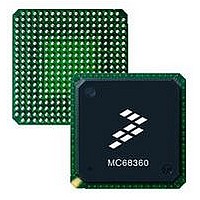MC68EN360CAI25L Freescale Semiconductor, MC68EN360CAI25L Datasheet - Page 565

MC68EN360CAI25L
Manufacturer Part Number
MC68EN360CAI25L
Description
IC MPU QUICC 25MHZ 240-FQFP
Manufacturer
Freescale Semiconductor
Series
MC68000r
Datasheets
1.MC68EN302AG20BT.pdf
(8 pages)
2.MC68EN360VR25L.pdf
(14 pages)
3.MC68EN360VR25L.pdf
(2 pages)
4.MC68EN360CAI25L.pdf
(962 pages)
Specifications of MC68EN360CAI25L
Processor Type
M683xx 32-Bit
Speed
25MHz
Voltage
5V
Mounting Type
Surface Mount
Package / Case
240-FQFP
Core Size
32 Bit
Cpu Speed
25MHz
Embedded Interface Type
SCP, TDM
Digital Ic Case Style
FQFP
No. Of Pins
240
Supply Voltage Range
4.75V To 5.25V
Rohs Compliant
Yes
Family Name
M68xxx
Device Core
ColdFire
Device Core Size
32b
Frequency (max)
25MHz
Instruction Set Architecture
RISC
Supply Voltage 1 (typ)
5V
Operating Supply Voltage (max)
5.25V
Operating Supply Voltage (min)
4.75V
Operating Temp Range
-40C to 85C
Operating Temperature Classification
Industrial
Mounting
Surface Mount
Pin Count
240
Package Type
FQFP
Lead Free Status / RoHS Status
Lead free / RoHS Compliant
Features
-
Lead Free Status / Rohs Status
Compliant
Available stocks
Company
Part Number
Manufacturer
Quantity
Price
Company:
Part Number:
MC68EN360CAI25L
Manufacturer:
APLHA
Quantity:
12 000
Company:
Part Number:
MC68EN360CAI25L
Manufacturer:
Freescale Semiconductor
Quantity:
10 000
Part Number:
MC68EN360CAI25L
Manufacturer:
FREESCALE
Quantity:
20 000
- MC68EN302AG20BT PDF datasheet
- MC68EN360VR25L PDF datasheet #2
- MC68EN360VR25L PDF datasheet #3
- MC68EN360CAI25L PDF datasheet #4
- Current page: 565 of 962
- Download datasheet (4Mb)
Freescale Semiconductor, Inc.
Serial Communication Controllers (SCCs)
In addition, the QUICC has additional pins used to interface to an optional external content-
addressable memory (CAM). These pins are described in 7.10.23.7 CAM Interface.
External to the EEST are the passive components (principally transformers) required to con-
nect to AUI or twisted-pair media. For more information on the EEST connection circuits,
refer to the MC68160 device description.
The QUICC stores every byte received after the start frame delimiter into system memory,
using the SDMA channels. On transmit, the user provides the destination address, source
address, type/length field, and the transmit data. The QUICC will automatically pad frames
that have less than 46 bytes in the data field to meet the minimum frame requirements. In
addition, the QUICC will append the FCS to the frame.
7.10.23.5 ETHERNET CHANNEL FRAME TRANSMISSION. The Ethernet transmitter is
designed to work with almost no intervention from the host. When the host enables the
transmitter, the Ethernet controller will poll the first Tx BD in the channel’s Tx BD table. The
poll occurs every 128 serial clocks. If the user has a frame ready to transmit, the TOD bit in
the transmit-on-demand register may be set to eliminate waiting for the next poll to occur.
When there is a frame to transmit, the Ethernet controller will begin fetching the data from
the data buffer, assert TENA to the EEST, and start transmitting the preamble sequence,
the start frame delimiter, and then the frame information. However, the controller will defer
the transmission if the line is busy (carrier sense is active). Before transmitting, the controller
waits for carrier sense to become inactive. Once carrier sense becomes inactive, the con-
troller determines if carrier sense stays inactive for 6.0 s. If so, then the transmission will
begin after waiting an additional 3.6 s (i.e., 9.6 s after carrier sense originally became
inactive).
If a collision occurs during the transmit frame, the Ethernet controller follows the specified
backoff procedures and attempts to retransmit the frame until the retry limit threshold is
reached. The Ethernet controller stores the first 5 to 8 bytes of the transmit frame (8 bytes
if the transmit frame was long-word aligned) in internal RAM, so that they do not have to be
retrieved from system memory in case of a collision. This improves bus utilization and
latency in the case that the backoff timer output results in a need for an immediate retrans-
mission. If a collision occurs during the transmission of the frame, the Ethernet controller will
return to the first buffer for a retransmission. The only restriction is that the first buffer should
contain at least 9 bytes.
When the end of the current BD has been reached and the L-bit in the Tx BD is set, the FCS
(32-bit CRC) bytes are appended (if the TC bit is set in the Tx BD), and TENA is negated.
This tells the EEST to generate the illegal Manchester encoding that signifies the end of the
Ethernet frame.
Following the transmission of the CRC, the Ethernet controller writes the frame status bits
into the BD and clears the R-bit. When the end of the current BD has been reached, and the
L-bit is not set (i.e., a frame is comprised of multiple buffers), only the R-bit is cleared.
MC68360 USER’S MANUAL
For More Information On This Product,
Go to: www.freescale.com
Related parts for MC68EN360CAI25L
Image
Part Number
Description
Manufacturer
Datasheet
Request
R
Part Number:
Description:
Manufacturer:
Freescale Semiconductor, Inc
Datasheet:
Part Number:
Description:
Manufacturer:
Freescale Semiconductor, Inc
Datasheet:
Part Number:
Description:
Manufacturer:
Freescale Semiconductor, Inc
Datasheet:
Part Number:
Description:
Manufacturer:
Freescale Semiconductor, Inc
Datasheet:
Part Number:
Description:
Manufacturer:
Freescale Semiconductor, Inc
Datasheet:
Part Number:
Description:
Manufacturer:
Freescale Semiconductor, Inc
Datasheet:
Part Number:
Description:
Manufacturer:
Freescale Semiconductor, Inc
Datasheet:
Part Number:
Description:
Manufacturer:
Freescale Semiconductor, Inc
Datasheet:
Part Number:
Description:
Manufacturer:
Freescale Semiconductor, Inc
Datasheet:
Part Number:
Description:
Manufacturer:
Freescale Semiconductor, Inc
Datasheet:
Part Number:
Description:
Manufacturer:
Freescale Semiconductor, Inc
Datasheet:
Part Number:
Description:
Manufacturer:
Freescale Semiconductor, Inc
Datasheet:
Part Number:
Description:
Manufacturer:
Freescale Semiconductor, Inc
Datasheet:
Part Number:
Description:
Manufacturer:
Freescale Semiconductor, Inc
Datasheet:
Part Number:
Description:
Manufacturer:
Freescale Semiconductor, Inc
Datasheet:











